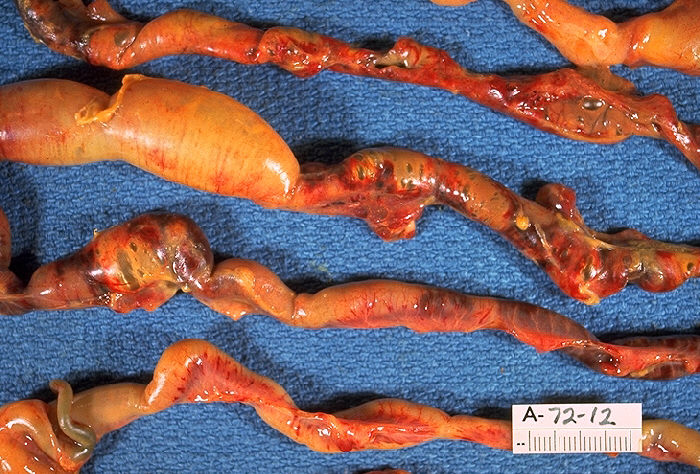Serial Transverse Enteroplasty on:
[Wikipedia]
[Google]
[Amazon]
Serial transverse enteroplasty (STEP) is a surgical procedure used primarily in the treatment of short bowel syndrome (SBS). In STEP, by making cuts in the intestine and creating a zigzag pattern, surgeons lengthen the amount of bowel available to absorb nutrients. The procedure was first performed in 2003 and more than 100 patients had undergone the surgery by 2013.
 Short bowel syndrome (SBS) is the condition in which a patient cannot absorb adequate nutrients because a portion of the small intestine is damaged or absent. SBS commonly affects pediatric patients who have undergone surgery, such as premature infants with necrotizing enterocolitis and infants with gastrointestinal defects such as
Short bowel syndrome (SBS) is the condition in which a patient cannot absorb adequate nutrients because a portion of the small intestine is damaged or absent. SBS commonly affects pediatric patients who have undergone surgery, such as premature infants with necrotizing enterocolitis and infants with gastrointestinal defects such as
Background
 Short bowel syndrome (SBS) is the condition in which a patient cannot absorb adequate nutrients because a portion of the small intestine is damaged or absent. SBS commonly affects pediatric patients who have undergone surgery, such as premature infants with necrotizing enterocolitis and infants with gastrointestinal defects such as
Short bowel syndrome (SBS) is the condition in which a patient cannot absorb adequate nutrients because a portion of the small intestine is damaged or absent. SBS commonly affects pediatric patients who have undergone surgery, such as premature infants with necrotizing enterocolitis and infants with gastrointestinal defects such as gastroschisis
Gastroschisis is a birth defect in which the baby's intestines extend outside of the abdomen through a hole next to the belly button. The size of the hole is variable, and other organs including the stomach and liver may also occur outside the ...
. In adults, Crohn's disease
Crohn's disease is a type of inflammatory bowel disease (IBD) that may affect any segment of the gastrointestinal tract. Symptoms often include abdominal pain, diarrhea (which may be bloody if inflammation is severe), fever, abdominal distension, ...
is a possible cause of SBS. If they are unable to absorb nutrients in the gut, patients must be given parenteral nutrition
Parenteral nutrition (PN) is the feeding of nutritional products to a person intravenously, bypassing the usual process of eating and digestion. The products are made by pharmaceutical compounding companies. The person receives a nutritional m ...
(PN) intravenously, but long-term PN can be associated with liver failure.
History
The procedure was studied by researchers in Boston utilizing a group of ten young pigs. Five of the pigs underwent removal of 90 percent of the bowel followed by STEP. The other pigs underwent the bowel resection without the STEP procedure, serving as control subjects. STEP was shown to lengthen the bowel from 105.2 ± 7.7 cm to 152.2 ± 8.3 cm. STEP was first performed on a human patient, a two-year-old who had been born with gastroschisis, in 2003. By 2010, it had been utilized by more than 20 hospitals, mostly in the United States."Serial transverse enteroplasty (STEP) for patients with short bowel syndrome (SBS)." ''Horizon Scanning in Surgery: Application to Surgical Education and Practice''.American College of Surgeons
The American College of Surgeons is an educational association of surgeons created in 1913.American College of Surgeons Online "What is the American College of Surgeons?"/ref>
See also
*American College of Physicians
The American College ...
, December 2010. In addition to its use in treating SBS, STEP has been utilized to treat bacterial overgrowth in a dilated bowel loop and to prevent SBS upon the initial repair of certain types of intestinal atresia.
In 2004, the International Serial Transverse Enteroplasty (STEP) Data Registry was created to serve as an online database to study outcomes following STEP. By 2013, 111 patients had been entered into the database, though 14 had been lost to follow-up. At that time, 11 patients had died and five had received intestinal transplants. 47% had attained enteral autonomy (sufficient bowel function). Pre-STEP bowel length was found to be inversely proportional to the likelihood of transplant or death. Pre-STEP direct bilirubin levels were found to be proportional to the likelihood of transplant or death.
Procedure
In STEP, the bowel is dilated and then partially transected (cut) at certain points, creating a zigzag pattern to the bowel that results in lengthening of the surface area available for digestion. Longitudinal intestinal lengthening and tapering (LILT), also known as the Bianchi procedure, is a surgical alternative to STEP. LILT and STEP have similar outcomes. With each procedure, more than half of patients gain the ability to absorb sufficient nutrients in the intestine. A single-center study compared STEP and LILT, reporting fewer complications with LILT.References
{{reflist, 30em Digestive system surgery